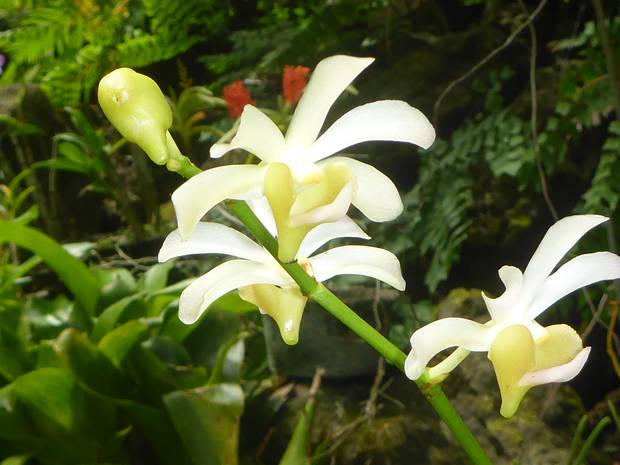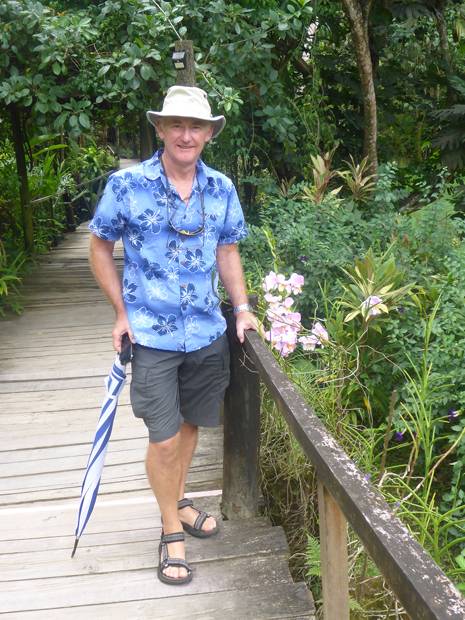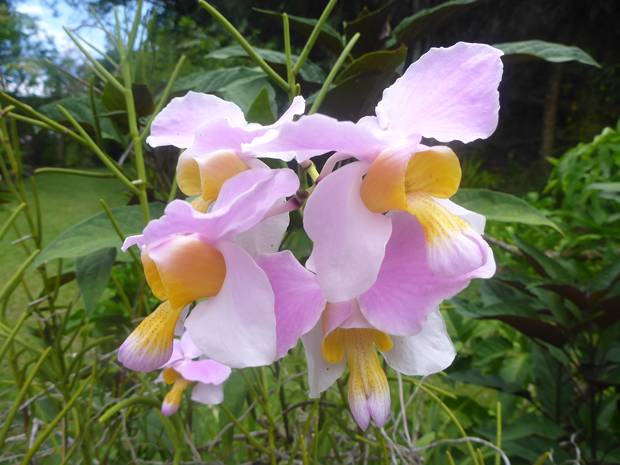The Garden beneath the Sleeping Giant

|
To the Garden of the Sleeping Giant I say ‘To’ because the journey there and back to Zoonie was an integral part of the day. Lami Bay awoke under pearl pink skies and Suva’s lights were still bright in the gap between a wooded island and the small promontory dotted with detached homes that marks the eastern end of our bay. By 7.20am we were washed, breakfasted and standing beside the bus stop beneath a tall tree in which the barking pigeons were making their warm rounded woofing sounds. The local buses are vintage, goodness knows how old but I wouldn’t be surprised if they were on the road when I was born. Lots have no windows, just plastic sheets the traveller can tug down if it starts raining. They are tough, they must be to carry full loads all day, seven days a week, year in year out. They fill up with happy people, off to school or work or just on a shopping trip and they are essential because a mobile population is a happy population and where most Fijians will never be able to afford a car they can afford the 40p into town. So we were curious to see how much the sleek grey fleet of modern long distance coaches cost to go from here along the 4 hour journey to Nadi Airport, £5.76 each. Again the coach was almost full and we sat separately for the first part of the journey along the south coast of Viti Levu where just a short distance from the main town the lifestyle of the Fijians reverted to the simple village life we had seen all over the islands. Well-kept vegetable gardens, neat homes, a stand by the road for selling fresh produce, small fishing boats bobbing on rock anchors or tied to plastic bottle buoys, dogs romping along on a mission and folk bent double tending their crops. The coach had efficient air conditioning but the Fijians find it too cold so as time passes the little vents above their heads are closed leaving just our two aiming localised cool air down on us. After a few passengers alight at their destinations I go and join Rob and our journey continues in happy silence with the occasional comment until we arrive at the modern airport terminus and relish the cool air on our walk to the loos. No eating, drinking, peeing or anything else is allowed on the hallowed coaches, just breathing, sitting and looking! The Indo-Fijian taxi driver chatted to us about his home in the area as he drove us the 15 minutes to the gardens, the last part up a bumpy rough track. “I will wait for you” we agreed on a time that would give us one and a half hours and save him three more runs along the rough track and some fuel. He turned in to what he remembered as the entrance but the road was closed. A vehicle driver behind us explained there was a newer entrance further up the hill. The main building was wooden, high roofed and shady. White painted dining and easy chairs dotted the room. Our timing was perfect as the main tours are mid-morning and mid-afternoon so we were among the very few there. I wonder if Raymond Burr had thought of the appeal of his garden being enhanced considerably by its location so near the airport when he decided to bring his own collection of orchids here in 1977. One of the gardeners greeted us and noting the grey skies further inland handed Rob a big umbrella, “You might need this my friend”. For less than £7 each the pretty vista unfolded. The concept reminded me of Heligan Gardens in Cornwall just behind Mevagissey. There a fine house was built atop the valley and gardens laid out down the irregular valley shape. Raymond’s own villa was just a few miles away but this idea of using the rugged, sheltered walls of a small valley for a garden was just the same. We wandered slowly up the wooden boardwalk tunnel, with a rockery on the right and a roof and left wall of black mesh. His orchids were in concrete pots standing in the rockery, orchids so like to be confined don’t they, and lighter baskets hanging from supports on the left. One favourite of mine was the little blue topped and eared flower that appears to be sticking its white tongue out at the viewer. A flourishing fuchsia-coloured bougainvillaea languished on the netting roof and caused it to bend under the weight and further up another, this time growing on the inside, pushed upwards through the netting. At the top of this rise we had our first clear view of the Giant’s head on the skyline facing the sky, his gently rounded forehead on the left, then his nose and mouth to the right and the sky his blanket. Whether Raymond found this himself or was shown it I do not know but it cannot be seen from the track as it is lost against higher ground, so he must have climbed up the valley in the early days, negotiating the ravine and numerous composite volcanic boulders before deciding to buy the section. The brochure referred to the ‘cool’ valley and indeed the moisture that keeps the foliage so lush here, despite this being the dryer side of the island, will have come from cool sea air meeting the warmer air off the land and condensing into penetrating, saturating mist. But today it was hot and humid with another spell of thunderstorms brewing. We were fortunate to have blue skies and sunshine. ‘I like it here in my pond with all my buddies around me. We frogs sit on our lily pads all day long watching folk taking photos of us and looking all around them. We love water and so do these two walking down towards us now. During a day we will probably hop around our pond maybe twice but these two, well they like water as well and they are hopping around the big pond. I wouldn’t like that, too deep and not enough flies. Excuse me I think I will move I appear to be sinking’. The water was only a few inches deep in fact, that’s all it takes to create an area in which nature can run riot and create such beauty. I took Emily to Monet’s garden in Giverny when she was almost a teenager. We had to cross a small road infront of his house and formal garden to find the water-garden. He had bought a small area of land at the side of a field with a little stream running through it from the local farmer and built a little dam and overflow system and then created his semi-natural wonder in less than a half metre of water. Arching willows, Japanese bridges and a riot of water plants, quite lovely. A little further on we detoured right to follow the native forest walk and along it there were numerous little paths that led nowhere but one, or two, could venture up them and around the curve at the end to really feel ‘lost’ in the jungle, or to hide from your playmate, imagine oneself miles from anywhere or steal a kiss. A deep streambed had been dry for a while, in it grew red stemmed taro plants their roots pushing deep for moisture. In this deliciously rustic place it seemed strange to come across a long wide rise of steps carefully painted white and leading up to a traditionally shaped Fijian meeting house with its high roof and walls made entirely of supported green foliage. The stairway was bordered with lush reddish plants and would be a fantastic venue for a wedding. All sorts of questions arose in my mind which we could have asked had we been on a guided tour. Also we would have learned a lot more, but because there were so few of us taking in the gardens at our own pace the experience was an aesthetic one rather than educational. The gardens are small and intimate so one can whizz through or linger all day for a picnic near the pond with sturdy swings nearby for the children of all ages to play on and of course those little paths with their many uses. We had quite a while between meeting our taxi and meeting the coach so the taxi driver said he would take us on a little tour up the valley where he grew up, past his neat home sitting in its own garden. “That was my school, it had its centenary this year.” We had agreed a price at the start, $50 instead of $60 if he had come back to the gardens to collect us and he threw in his entertaining family history as an act of hospitality. One of those pleasant unexpected surprises. I had another pleasant surprise on the coach. I sat down next to a middle aged lady and across the aisle from Rob, best of both worlds. We started a non-stop conversation that lasted for two hours before Rob’s neighbour left the bus and my neighbour said “I don’t mind if you go back to your husband now”. I was torn as it’s not often I get the chance for a good natter with a local. We also moved to seats further forward as we had asked the bus driver if he would stop at the Novotel rather than us having to go all the way to Suva only to come back out again and we wanted to be able to remind him. So when we stopped again I slipped back to her to explain we had moved to be nearer the front to get off and at the next stop she came forward, tapped my arm and said “Safe journey to New Zealand”. Now in the last blog you will have seen the little wooden plank we have to negotiate from the tilting rotten pontoon onto the concrete harbour wall. It’s no problem around high tide and when it is dry but on this occasion it was low, low tide and damp. Rob went down first and as I waited I noticed two of the night shift policemen emerging from the shadows of their gazebo ready to assist if necessary. I dragged my thoughts back from sea snakes and dirty water to the centre line of the steep and twisted plank. First foot on and let it slide down to the wooden cross piece, then commit knowing there were three strong men ready to fish me out if needed. Arms out as if walking a tight rope and keep that balance. Once I was over the watery gap I was fine and on stepping onto the soft wood I turned, waved and whispered “Vinaka” (thank you) to the receding figures. The end of another perfect day.
|



















